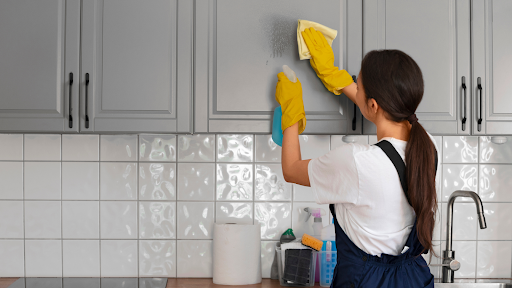Moving out of a rented property can be an exciting yet stressful experience. One of the most critical aspects of the process is ensuring that your end-of-tenancy cleaning is up to standard. Many tenants face issues with their deposit return simply because they miss a few essential cleaning tasks.
In this guide, we’ll discuss the common cleaning gaps that arise during rental property cleaning inspections and provide helpful tips on how to avoid them.
Why End Of Tenancy Cleaning Matters
- End-of-tenancy cleaning is crucial for ensuring the property is returned in good condition.
- It directly impacts your chances of getting your full deposit back.
- A thorough clean demonstrates responsibility and care for the property, which is appreciated by landlords and property managers.
- If cleaning is not done to the required standard, the landlord may deduct cleaning costs from the deposit.
- Attention to small details is essential, as these are often where cleaning gaps are found.
Key Areas Often Overlooked In End-Of-Tenancy Inspections
01. Neglecting the Kitchen Appliances
The kitchen is highly scrutinised, and while surfaces are cleaned, appliances are often overlooked despite being the most used and needing special attention.
- The Oven: Grease and food residue tend to accumulate in the oven over time. Make sure to give it a deep clean, focusing on the racks, trays, and door.
- The Fridge: Even if it’s empty, the fridge can harbour unpleasant smells if not cleaned properly. Wipe down all shelves and compartments, and ensure the fridge is defrosted and dry.
- The Microwave: Food splatters often go unnoticed in the microwave. Clean both the interior and exterior thoroughly.
By taking the time to clean these appliances during your end-of-tenancy cleaning, you’ll avoid losing money for something as simple as food stains.
02. Forgetting the Bathroom Details
Bathrooms are another area that often sees cleaning gaps. A quick wipe-down of surfaces may seem sufficient, but there are smaller, hard-to-reach areas that require attention.
- Shower Doors and Screens: Soap scum builds up easily on shower doors and screens. Use a glass cleaner or vinegar solution to remove any watermarks or residue.
- Toilet Seat and Lid: Many tenants clean the toilet bowl but forget the seat and lid. These areas are prone to grime and must be cleaned thoroughly.
- Behind the Sink and Toilet: Dirt and grime tend to collect behind these fixtures. Ensure you clean these often-missed spots to avoid any unpleasant surprises during the inspection.
Paying attention to these details can make all the difference and show your landlord that you’ve put in the effort.
03. Ignoring Skirting Boards and Light Fixtures
Skirting boards and light fixtures often get overlooked, accumulating dust and grime, which can be missed during the final inspection.
- Skirting Boards: Dust tends to accumulate along the edges of walls and floors. Use a damp cloth to wipe them down carefully.
- Light Fixtures: Dusting light fixtures is often overlooked, but they can accumulate a lot of dirt. Wipe down lampshades and bulbs, ensuring they shine bright once cleaned.
These areas might not seem important, but they’re often pointed out by landlords during the inspection, especially if they’re noticeably dusty.
04. Failing to Clean Windows and Window Tracks
Windows are often overlooked, with tracks and frames accumulating dirt, dust, and mould, leading to a poor inspection outcome.
- Window Frames: Wipe down window frames and the sills to remove any dust and grime.
- Window Tracks: These can collect dirt, dust, and even water, so clean them out to avoid a negative review from your landlord.
Incorporating these often-overlooked tasks into your move-out cleaning routine will help ensure that every detail is covered.
05. Not Deep Cleaning Carpets and Flooring
Many tenants forget that deep cleaning carpets and flooring is essential. Vacuuming is often enough to remove surface dirt, but carpets need a more thorough cleaning.
- Carpets: If the carpet is stained, consider hiring a professional cleaner or using a carpet cleaning solution. This can help lift stubborn stains and ensure the carpet looks presentable.
- Hard Floors: Sweeping and mopping hard floors might seem sufficient, but pay attention to corners and edges where dirt tends to collect.
06. Overlooking Outdoor Spaces
If your property has a garden or outdoor area, ensure it’s cleaned as landlords expect it to be in good condition, even if it’s often overlooked.
- Mowing the Lawn: If applicable, mow the lawn and trim any overgrown bushes or hedges.
- Patios and Walkways: Sweep patios and walkways to remove leaves, dirt, and debris.
Cleaning outdoor spaces is a small but important task in your move-out cleaning, particularly if the landlord values the upkeep of the property’s exterior.
How To Avoid Common Cleaning Gaps
01. Create a Detailed Cleaning Checklist
A cleaning checklist is essential to avoid missing any crucial areas. Break down each room and its cleaning tasks to ensure no corner is left untouched.
02. Start Early
Don’t wait until the last minute to clean. Starting early allows you to address any issues that may arise during the cleaning process and ensures you have ample time to complete the job thoroughly.
03. Use Professional Cleaning Services
If you’re unsure whether your cleaning will meet the required standards, consider hiring a professional cleaning service. They have the expertise and equipment to handle all aspects of rental property cleaning, ensuring a job well done.
Final Thought
End-of-tenancy cleaning can be stressful, but focusing on common gaps like the kitchen, bathroom, skirting boards, light fixtures, and windows can prevent deposit deductions. Plan, use a checklist, and consider professional help for a thorough job.
These steps will ensure a smooth inspection and a full deposit return, with the property returned in excellent condition.

